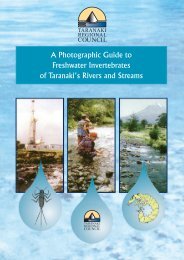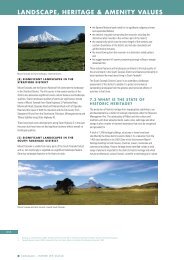Annual report 2006-2007 - Taranaki Regional Council
Annual report 2006-2007 - Taranaki Regional Council
Annual report 2006-2007 - Taranaki Regional Council
You also want an ePaper? Increase the reach of your titles
YUMPU automatically turns print PDFs into web optimized ePapers that Google loves.
31<br />
also referred to the new consent 6570 granted in the monitoring year under review,<br />
however a waste burial management plan is required under the new consent to bury<br />
raw degenerating product to land. Matters that should be addressed in the<br />
management plan are detailed in special condition 5. Many of these matters have<br />
been addressed in the contingency plan, however some still need to be detailed or<br />
expanded on further. This will be addressed in the upcoming monitoring year.<br />
2.6.2 Environmental effects of exercise of consents<br />
The low flow water quality survey indicated that the discharge was increasing the<br />
BOD5 above consented levels in the receiving water, and elevating the nutrients in<br />
the Kahouri Stream downstream of the confluence with the tributary that receives<br />
the <strong>Taranaki</strong> Abattoir discharge to well in excess of ANZECC water quality<br />
guidelines.<br />
The results of the April <strong>2007</strong> biomonitoring survey indicated that the communities<br />
directly downstream of the tributary that receives the <strong>Taranaki</strong> Abattoirs and<br />
Ballance Agri-Nutrients discharges were significantly different than those upstream,<br />
where taxa richness and MCI score were slightly healthier than median community<br />
conditions recorded previously at this ‘control’ site. There was a significant decrease<br />
in MCI and SQMCIS scores at the lower site, which may have been due to additional<br />
instream nutrients supplied by the tributary. This is likely to be due to the impacts<br />
from the abattoir, but this is unclear without further monitoring. Therefore it is<br />
recommended that additional sites be included in subsequent surveys to assess the<br />
impact of the abattoir discharge on this unnamed tributary.<br />
In relation to air emissions, in the <strong>2006</strong>-<strong>2007</strong> year, there were 5 incidents related to<br />
odours emitted outside the site boundary, 1 of which was considered to be offensive<br />
and therefore did not comply with special condition 3 of consent 4055, having<br />
significant adverse effects on neighbouring properties. This consent condition<br />
requires that at no time shall the consent holder cause or allow an odour at or past<br />
the legal boundary of the consent holder’s site that in the opinion of an enforcement<br />
officer of the <strong>Taranaki</strong> <strong>Regional</strong> <strong>Council</strong> is noxious or offensive or objectionable.<br />
Further, on one occasion, it was found that non-condensable gases were being vented<br />
direct to air, which did not comply with special condition 17.<br />
In response to the discharge of objectionable odours, one infringement notice was<br />
issued during the <strong>2006</strong>-<strong>2007</strong> monitoring year. This is a significant improvement from<br />
the previous monitoring year, in which the Company was prosecuted for the<br />
discharge of objectionable odour.<br />
2.6.3 Evaluation of performance<br />
A tabular summary of the Company’s compliance record for the year under review is<br />
set out in Tables 7 to Table 11.














